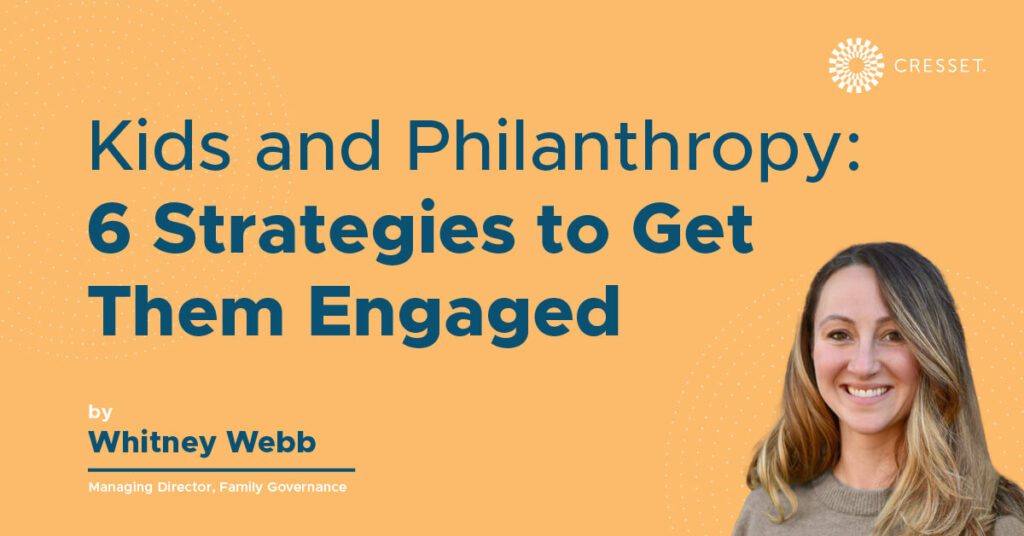
By Whitney Webb, Managing Director, Family Governance
One of the most common frustrations we hear from philanthropic-minded clients is the lack of engagement from their children and grandchildren. “I’ve tried several times to get my kids to help decide where we donate money as a family, but they don’t seem interested,” is a recurring outcry in many families. At the heart of this frustration is a parent’s hope for their children to be generous and compassionate members of society. However, it can be complicated to figure out the logistics of involving younger generations in donating time and financial resources. Below are several strategies to consider to not only get them involved but get them excited about giving back.
- Share the joy, not the obligation. With endless lists of to do’s, adding philanthropy to a young person’s list can unfortunately instill negative emotions about giving. Studies support this, finding that giving that is required brings less satisfaction than making the decision on one’s own. Model generosity through acts of service, donating resources, and sharing personal stories of impact or ways other philanthropists have succeeded in making a positive impact.
- Help with the “paradox of choice.” With over 10 million non-profits in the world, choosing those to support can become paralyzing. If you suspect your family members might be overwhelmed by the question, “What / who are you interested in supporting?” try referencing The Global Goals and help them learn about and prioritize the issues they care about. Stanford PACS also has some great tools to help narrow in on a personal philanthropic mission.
- Provide hands-on experience. Studies show that people who spend time volunteering or seeing issues firsthand tend to give more money to those charities. If possible, planning family volunteer days, engaging in service learning whether at home or abroad often sparks philanthropic interest and action. If a volunteer outing is not possible, have a conversation with your kids about what it might be like to volunteer at a specific organization. Ask them, “What would be the best part and what might be some of the challenges? How might you feel after spending a day giving your time?” Research finds that even imagining time spent volunteering at an organization leads to greater donations.
- Avoid “over engagement”. Parents generally have the best intentions when asking their children to join them in their philanthropic endeavors. However, patience is key because the ideal timing for a parent might not be the best time for the children. Oftentimes, parents will extend request after request to do research, volunteer, or pitch ideas, but this can lead to resentment, guilt, and overload the younger generation. The goal is to empower, not enforce, so provide opportunities at a moderate pace until the timing seems to be right to amp up engagement. A good place to start is asking for straightforward advice such as “I’m considering supporting one of these two organizations, which do you think is doing the most impactful work based on the needs you see in the world?” Or “What questions do you think I should ask them to learn more?”
- Support individualized paths. Building off of the point above, don’t expect that if you have three children they will all be interested in getting involved at the same time or in the same way. The best place to start is with the child who shows the most interest and, likely, the other members of the family will come around when the time is right and they see firsthand the joy from their sibling(s). Help each family member explore the causes that speak to them by connecting ways to make an impact with their current passions. I have seen a musically gifted teenager run a free music writing workshop for children, a young woman interested in cooking set up a homemade ice cream fundraiser, and a young boy who loved insects become engrossed in wildlife protection. When young people are able to explore their passions alongside making the world a better place, those experiences can help instill a personal positive relationship with giving back.
- Bake it into the culture of your family. Helping others, feeling valued, and being part of something bigger than ourselves feels good and is often linked to positive mental health benefits. Ideally beginning when your kids are young, consider making volunteer projects or service learning a routine activity for all members of your family. Set clear expectations, model the behavior, and stay consistent. Along with chores, academics, athletics, and family time, when done early, providing structure for your kids to be a part of something bigger than themselves can be a gift to them along with society.
Contact Cresset to learn how we can help you engage the next generation in philanthropic giving.
About Cresset
Cresset is an independent, award-winning multi-family office and private investment firm with more than $235 billion in assets under management and advisement (as of 10/31/2025). Cresset serves the unique needs of entrepreneurs, CEO founders, wealth creators, executives, and partners, as well as high-net-worth and multi-generational families. Our goal is to deliver a new paradigm for wealth management, giving you time to pursue what matters to you most.
https://cressetcapital.com/disclosures/
